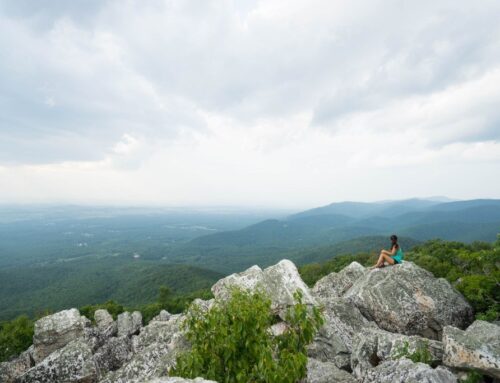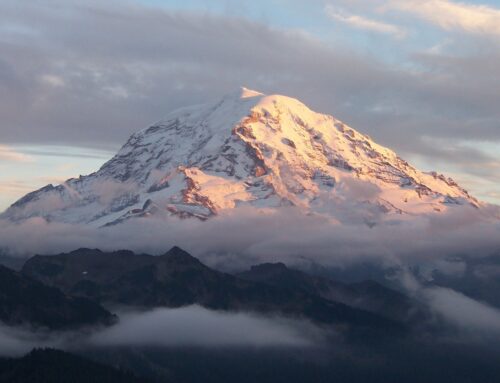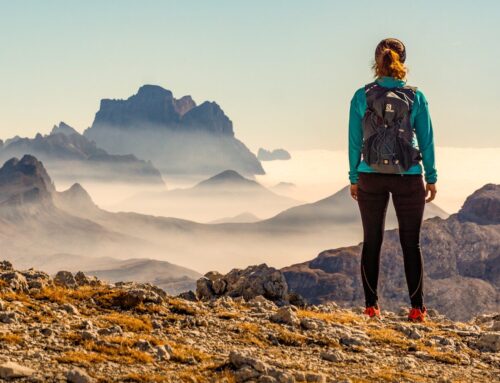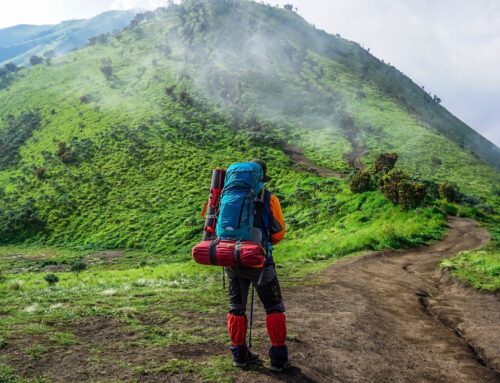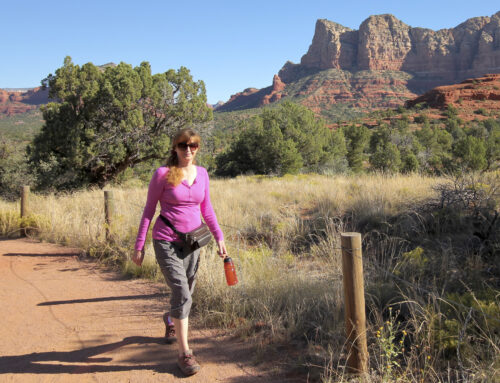Updated July 15, 2022
It’s no secret that more and more people are finding enjoyment in the outdoors. As people flock to nearby trails and nature areas, it’s critical to learn strategies for protecting and preserving our urban green spaces…which is where Leave No Trace comes in. Most people think of Leave No Trace when it comes to national parks or the backcountry, but these principles are just as important (or even more so) in the city and the suburbs.
You may have heard of Leave No Trace as a philosophy, an organization, a course, or something else. It’s all of these things and more. From our perspective, Leave No Trace is a mindset and a tool. In this guide, we introduce Leave No Trace and explain the basics of the Seven Principles, which can help us all become better stewards for conservation and sustainable recreation in our own cities and nature areas.
What Is Leave No Trace?
Coined by an educational nonprofit with the same name, Leave No Trace’s Seven Principles were created to inform the public how to recreate sustainably in public lands. Today, the Principles serve as a map for us to follow to protect these nature areas. They provide a blueprint for ways to think, act, and react while doing activities outdoors to protect the spaces we are all actively enjoying.
The Seven Leave No Trace Principles are:
- Plan Ahead & Prepare
- Travel & Camp on Durable Surfaces
- Dispose of Weights Properly
- Leave What You Find
- Minimize Campfire Impacts
- Respect Wildlife
- Be Considerate of Others

Why Do We Need Leave No Trace in Urban Green Spaces?
Raise your hand if you’ve ever seen trash on a hiking trail, or in a river you’re paddling through. Or if you’ve seen news coverage on rampant wildfires and wildlife affected by pollution. Or if you’ve felt like a trail was overcrowded and cramped.
If you’ve been outside lately, you’ve probably raised your hand for at least one of these things.
Leave No Trace addresses many of these issues and more. Instead of governments and organizations having to fund restoration and repairs of public trails and waterways, Leave No Trace takes a preventative approach to conserving wild spaces and ensuring that outdoor participants are using lands sustainably. We need Leave No Trace and its principles to educate the masses about the effects of human activities on natural spaces, and how we can mitigate those effects through some very simple, effective actions.
How to Apply Leave No Trace in Local Parks, Trails & Waterways
Plan Ahead & Prepare
The first step before embarking on any outdoor adventure is to plan ahead and prepare. While this may seem self-explanatory, it’s surprisingly easy to be unprepared for any outdoor activity. From planning your adventure to the apparel and gear you bring, you should always plan ahead before embarking on a trail or waterway.
In trails around your city, it’s just as important to plan and prepare before you depart. While you may not be traveling far or going deep into the backcountry, adequate preparation for an outdoor activity is critical. Here are a few ways to plan & prepare for a local outdoor adventure:
- Choose your activity, trail, and waterway based on your skill level and the seasonal conditions.
- Make sure your route does not pass through private property.
- Know of any required entrance fees or permits required for your activity.
- Coordinate with your adventure buddies to make sure everyone knows the meeting place and game plan.
- Determine how you’re going to get there, especially if you are taking public transportation.
- Make sure that you have all of the necessary gear and apparel.
- Before heading out, check the weather.
Travel & Camp on Durable Surfaces
For those recreating on land, you can protect nature areas by always traveling & camping on durable surfaces. In plain English, this means that you should only set foot on areas that can withstand human foot traffic. Trails and established campsites are typically a great place to start. However, things can get a little more seedy when you need to head off-trail to use the bathroom or go camping in the backcountry.
- Stay on designated trails whenever possible.
- Avoid walking or resting in areas of vegetation or non-solid ground.
- When camping, opt for designated campsites or durable backcountry areas.
- Be sure to read and understand local ordinances regarding where you can or cannot camp. Do not camp where it is prohibited!

Dispose of Waste Properly
Waste from human activities can be a huge source of pollution on trails, in forests, and in waterways. It’s important to dispose of waste properly when recreating in nature areas. This may be the most common principle people think of when they hear “Leave No Trace.” From trash to waste water, waste on the trails can come in many forms and must be disposed of properly to avoid interference with local plant and animal species.
If you aren’t sure where to begin with disposing waste on the trail, follow the mantra of “when in doubt, pack it out.” All trash, food, and gear items should be taken with you and disposed of in a proper trash receptacle. Even food scraps and biodegradable items should be packed out with you. It’s easiest to bring a small plastic bag or a reusable trash sack to carry out disposable items while you’re on the trail.
In short, here are some Leave No Trace basics for urban green spaces:
- Minimize the use of single-use plastics. Opt for water bottles, tupperware, and other reusable items.
- Throw away all trash, food, and waste in a trash can. Recycle where possible.
- Only use the restroom in designated facilities or using the proper Leave No Trace “cat hole” protocols.
- Pick up after your pets and make sure they are leashed at all times in public spaces.
- Dispose of any wastewater from picnics or washing at least 200 feet away from a body of water.
- When in doubt, pack it out.
Leave What You Find
Although it may be tempting to take souvenirs from your hikes and adventures, the fourth principle is to leave what you find. Yup, this is as simple as it sounds: look with your eyes, and not with your fingers. This means leaving interesting objects where you found them and not defacing trees, stones, or other artifacts. Don’t pick flowers, don’t steal seashells, don’t take a leaf or a rock or a branch to-go. Admire it, enjoy it, and then move on.
When I talk to people about this, I’m usually met with something like, “well, I’m just one person, what difference does it make?” Sure, it wouldn’t make a huge difference if just one person did it one time. But lasting impact comes from this mentality repeated over and over again, across hundreds of thousands of people. Leave all of the beautiful things you find for everyone to enjoy, and you’ll be doing the environment a favor, too.
- Leave behind all artifacts and nature elements – look, but don’t touch!
- Do not, under any circumstances, deface or vandalize trees, rocks, artifacts, or any natural elements. The same goes for urban artwork, murals, sculptures, and installations.

Minimize Campfire Impacts
Campfires can cause a huge impact on natural environments, and minimizing campfire impacts is a critical principle of Leave No Trace. When facing a decision of whether to use a campfire or a personal stove, we’d always recommend the stove. Stoves are cleaner, safer, and less wildfire-prone than a traditional campfire, and the environmental impacts of a gas-burning stove are little to none.
There may be some instances where a campfire makes sense or can be built safely, minimizing impact. In general, if you’re going to build a traditional campfire, it’s best to build a fire in an existing fire pit. When that’s not possible, build fires in areas where there will be limited damage to the backcountry. Put out all fires with water, not dirt, and ensure that there is nothing burning when you leave. Use firewood bought or provided locally, and strive to gather kindling and smaller pieces of wood from a wide area.
- Use a portable stove or grill where fire does not come in contact with the ground.
- For campfires, use only established fire pits and put all fires out with water before you leave the area.
- Follow local and state ordinances on fire safety. Many parks and preserves do not allow fires, and in some areas, campfires are not permitted during wildfire season.
Respect Wildlife
If you spend enough time outdoors, you’ll be sure to stumble across some sort of wildlife. But, as with all things in nature, it’s crucial to respect wildlife and look. When around wildlife, remain quiet and calm and avoid sudden movements. Stay a safe distance – usually 2 or more school bus lengths – and do not approach animals. Moreover, under no conditions should you feed or pet wildlife. This can greatly diminish and disturb animals’ natural patterns and behaviors. Animals can also transmit diseases to humans.
While camping, be sure to store food items correctly so that animals cannot reach them, and do not keep any food inside your tent. Many front country campsites in areas with lots of wildlife have bear boxes – use them.
- Don’t feed animals, even birds and fish. This can cause animals to become dependent on human interactions (aka, a nuisance) and change their behavioral patterns drastically.
- Stay a safe distance away from all wildlife, and do not attempt to pet or hold animals.
- Leash all dogs and try to prevent them from interacting with wildlife.
- Pick up all food scraps and trash to protect your local wildlife species.

Be Considerate of Others
The final Leave No Trace Principle is to be considerate of others while you’re outdoors (and in general). Ultimately, this boils down to staying out of other people’s way and respecting communal spaces where there are several people nearby. Here are a few simple ways you can be considerate and polite on the trails:
- Avoid listening to music without headphones.
- When possible, avoid peak times and holidays on trails and waterways. Opt to get outdoors on weekdays or early in the morning on weekends.
- Follow proper hiking etiquette.
- Don’t block or crowd public trails.
- Do not smoke in crowded areas.
More Ways You Can Get Involved With Leave No Trace
For most people, knowing and understanding the 7 Leave No Trace principles and following them as much as possible is a great start in being stewards and protectors of the land. However, if preservation of nature areas and trails strikes a chord with you, there are several ways to get even more involved with Leave No Trace:
- Donate to the Leave No Trace organization
- Attend an event or workshop
- Take a course or certification in Leave No Trace education
- Become a member of Leave No Trace
- Volunteer with Leave No Trace
- If you own a business, consider becoming a Leave No Trace partner
The more you can do, the better we all are, because we’re empowered with education and resourced needed to protect every nature space we enjoy. From city parks to backcountry campsites, all nature spaces require and appreciate our attention. By following Leave No Trace principles whenever you get outside, you’ll be extending the lifespan of these treasured spaces and the environment around them.

